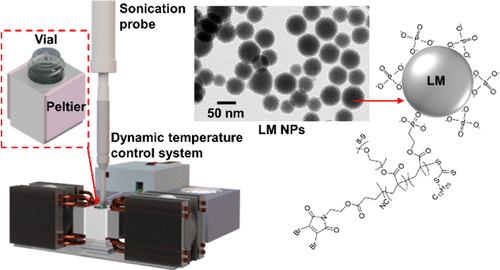当前位置:
X-MOL 学术
›
ACS Appl. Nano Mater.
›
论文详情
Our official English website, www.x-mol.net, welcomes your
feedback! (Note: you will need to create a separate account there.)
Dynamic Temperature Control System for the Optimized Production of Liquid Metal Nanoparticles
ACS Applied Nano Materials ( IF 5.3 ) Pub Date : 2020-06-17 , DOI: 10.1021/acsanm.0c01257 Hongda Lu 1 , Shi-Yang Tang 2 , Zixuan Dong 1 , Di Liu 1 , Yuxin Zhang 1 , Chengchen Zhang 3 , Guolin Yun 1 , Qianbin Zhao 1 , Kourosh Kalantar-Zadeh 3 , Ruirui Qiao 4 , Weihua Li 1
ACS Applied Nano Materials ( IF 5.3 ) Pub Date : 2020-06-17 , DOI: 10.1021/acsanm.0c01257 Hongda Lu 1 , Shi-Yang Tang 2 , Zixuan Dong 1 , Di Liu 1 , Yuxin Zhang 1 , Chengchen Zhang 3 , Guolin Yun 1 , Qianbin Zhao 1 , Kourosh Kalantar-Zadeh 3 , Ruirui Qiao 4 , Weihua Li 1
Affiliation

|
Nanoparticles (NPs) of gallium-based liquid metal (LM) alloys have potential applications in flexible electronics, drug delivery, and molecular imaging. They can be readily produced using top-down methods such as sonication. However, the sonication process generates heat that can cause dealloying of NPs through hydrolysis and oxidation of gallium. This limits the sonication power and period that can be applied for disrupting LM into smaller particles with high concentrations. Also, it remains challenging to achieve long-term colloidal stability of NPs in biological buffers. Here, we develop a dynamic temperature control system for improving the production performance of LM NPs. The enhanced performance is reflected by the significantly increased particle concentration, the decreased overall particle size, the prevention of the formation of oxide nanorods, and the versatility of producing NPs of different types of alloys. In addition, we design a brushed polyethylene glycol polymer with multiple phosphonic acid groups for effectively anchoring the NPs. More importantly, we discover that phosphate can effectively passivate the surface of NPs to further improve their stability. Using these strategies, the produced NPs remain stable in biological buffers for at least six months. Thus, the proposed methods can unleash the vast potential of LM NPs for biomedical applications.
中文翻译:

动态温度控制系统,用于优化液态金属纳米颗粒的生产
镓基液态金属(LM)合金的纳米粒子(NPs)在柔性电子,药物输送和分子成像中具有潜在的应用。可以使用自上而下的方法(例如超声处理)轻松生产它们。但是,超声处理会产生热量,该热量可通过镓的水解和氧化作用引起NP的脱合金。这限制了可用于将LM破碎成高浓度较小颗粒的超声处理能力和周期。同样,在生物缓冲液中实现NP的长期胶体稳定性仍然具有挑战性。在这里,我们开发了一种动态温度控制系统,以改善LM NP的生产性能。显着提高的颗粒浓度,减小的总颗粒尺寸反映了性能的提高,防止氧化物纳米棒的形成,以及生产不同类型合金的NP的多功能性。此外,我们设计了具有多个膦酸基团的拉丝聚乙二醇聚合物,可有效固定NP。更重要的是,我们发现磷酸盐可以有效地钝化NP的表面,以进一步提高其稳定性。使用这些策略,产生的NP在生物缓冲液中保持稳定至少六个月。因此,所提出的方法可以释放出LM NP在生物医学应用中的巨大潜力。我们发现磷酸盐可以有效地钝化NP的表面,以进一步提高其稳定性。使用这些策略,产生的NP在生物缓冲液中保持稳定至少六个月。因此,所提出的方法可以释放出LM NP在生物医学应用中的巨大潜力。我们发现磷酸盐可以有效地钝化NP的表面,以进一步提高其稳定性。使用这些策略,产生的NP在生物缓冲液中保持稳定至少六个月。因此,所提出的方法可以释放出LM NP在生物医学应用中的巨大潜力。
更新日期:2020-07-24
中文翻译:

动态温度控制系统,用于优化液态金属纳米颗粒的生产
镓基液态金属(LM)合金的纳米粒子(NPs)在柔性电子,药物输送和分子成像中具有潜在的应用。可以使用自上而下的方法(例如超声处理)轻松生产它们。但是,超声处理会产生热量,该热量可通过镓的水解和氧化作用引起NP的脱合金。这限制了可用于将LM破碎成高浓度较小颗粒的超声处理能力和周期。同样,在生物缓冲液中实现NP的长期胶体稳定性仍然具有挑战性。在这里,我们开发了一种动态温度控制系统,以改善LM NP的生产性能。显着提高的颗粒浓度,减小的总颗粒尺寸反映了性能的提高,防止氧化物纳米棒的形成,以及生产不同类型合金的NP的多功能性。此外,我们设计了具有多个膦酸基团的拉丝聚乙二醇聚合物,可有效固定NP。更重要的是,我们发现磷酸盐可以有效地钝化NP的表面,以进一步提高其稳定性。使用这些策略,产生的NP在生物缓冲液中保持稳定至少六个月。因此,所提出的方法可以释放出LM NP在生物医学应用中的巨大潜力。我们发现磷酸盐可以有效地钝化NP的表面,以进一步提高其稳定性。使用这些策略,产生的NP在生物缓冲液中保持稳定至少六个月。因此,所提出的方法可以释放出LM NP在生物医学应用中的巨大潜力。我们发现磷酸盐可以有效地钝化NP的表面,以进一步提高其稳定性。使用这些策略,产生的NP在生物缓冲液中保持稳定至少六个月。因此,所提出的方法可以释放出LM NP在生物医学应用中的巨大潜力。










































 京公网安备 11010802027423号
京公网安备 11010802027423号